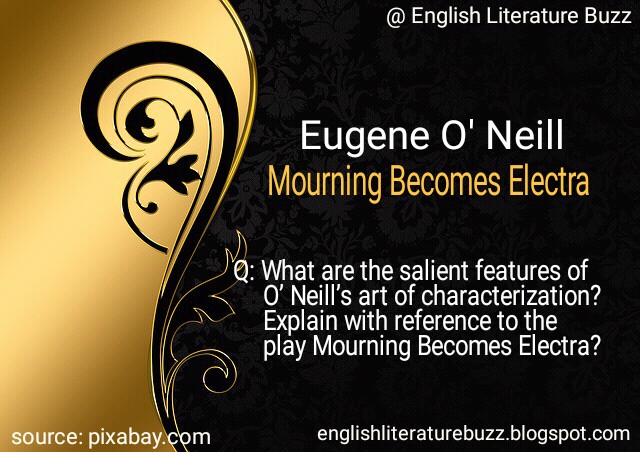Mourning Becomes Electra: Art of Characterization
 |
| Pixabay.com |
Q: What are the salient features of O’ Neill’s art of characterization? Explain with reference to the play Mourning Becomes Electra?
1- Thematic Characterization:
O’ Neill experimented with different techniques of characterization in different plays. His art of characterization, therefore, depends upon what kind of theme he is handling in a particular play.Since in Mourning Becomes Electra his theme is concerned with evil, death, war, Puritanism, freedom, is, therefore, is fundamentally thematic and meant to help in understanding the central idea of the play more clearly and easily.
2- The Great Novelist:
Mourning Becomes Electra represents the culmination of O’ Neill works in the theatre and is the triumph of his conscious art. It marks the high watermark of O’Neill’s critical success. O’Neill had always regarded it as his greatest work. In the words of Carpenter: “The logical perfection of Mourning Becomes Electra, and the sustained psychological intensity if it's feeling, produced an artistic work of great power.” The play is hailed as the greatest American tragedy. It is divided into three parts. The first and third each have four acts, and the middle one five. In all, it is a thirteen act trilogy.3- Victims of Evil:
O’ Neill’s characters in Mourning Becomes Electra particularly those belonging to the Mannon clan, are victims of evil. Especially Lavinia, who has been thinking of choosing Captain Peter Niles as her life- partner, has decided not to marry him because her father needs her more than anyone else. She is so much disgusted with Christine’s affair with Adam that her very faith in love is totally shattered. To stress this point, O’ Neill has forward his attention on the character of Lavinia.4- Quintessential Selves:
Mourning Becomes Electra by O’Neill patterned in Greek tragedy. O’Neill has followed Aeschylus and the Greek set of conventions on Mourning Becomes Electra. Mourning Becomes Electra is a work of contemporary New England Civilization. O’Neill has given an almost contemporary rearrangement of the first two parts of the Aeschylean trilogy. In the words of Engel: “Bearing aspects if Aeschylus and Euripides, it approximates neither.” In the Mourning Becomes Electra, he used a ready-made story into all the details and motives and reasons of which it was not necessary to go. If he had lived in Elizabethan England, he would probably have gone over to the backside and written plays in blank verse.5- Symbolic Device:
Instead of using masks to show what has happened to Orin and Lavinia, O’Neill simply states in his stage directions that they have come to resemble their parents. “I’m now”, says Orin,” in Father’s place and you’re Mother……… That’s the evil destiny out of the past I haven’t dared predict: I’m the Mannon you’re chained to!”Out of the mouth of the demented man has come the ultimate truth. Like the Cassandra, he perceives through his disordered mind the meaning of the curse.6- Psychological Motivation and Complexes:
In Mourning Becomes Electra O’ Neill appears to have made the psychological motivation. Freudian theories of characters are a version of reality that explains the crimes of the Mannons and their feelings of guilt. It has described the sinful love of the son for the mother and the daughter for the father as a universal, compulsive pattern. O’ Neill chose Freudian psychology to motivate the action. Freudianism, as it was understood or misunderstood, represented in the 1920s a definite complex of attitudes about the importance of the psyche as a key to human behavior.7- Chorus Characters:
O’Neill seems to have been aware of this difficulty, and he attempted to meet it by introducing a “Chorus” of “townsfolk….. as a human background for the drama of Mannons.” Exchange of Roles: Characters on O’Neill’s plays often exchange roles at different points in the drama. In Mourning Becomes Electra, after Christine has killed herself and Lavinia becomes fully a developed woman, she takes Christine’s place in the play as a whole, but especially for Orin who was so close to his mother. Adam Brant includes the identity if Marie Brantome and takes place from begging of the play, thus continuing his dramatic impact, even after her death, upon the Mannon family. When Lavinia returns with Orin from clipper ship in the fifth act of The Hunted, she represents all the Mannon harshness. She has completely taken the place of Ezra. When Lavinia becomes feminine, and in the process “becomes” Christines, there is no left to play Ezra and to fill this characters vacuum Orin becomes more like his father. So it is evident in this play that O’Neill’s characters often exchange their roles.8- Guilty Characters:
The main burden of guilt in the play is borne by the male characters. The older man in the Mannon family are all guilty of loving Marie Brantome, Adam Brant’s mother selfishly and destructively. Ezra Mannon is guilty of letting Marie die unaid, and he repeats this crime when he killed Christine’s love for him during their marriage.9- The Conclusion:
In Mourning Becomes Electra O’Neill into the full stretch of clear narrative design. He has come to what is so rare in Northern art.Related Topics:
For Whom The Bells Tolls: Jordan relationship with MariaJazz: Violet- character
